Chef Sarah Simmons: Celebrating the Everyday
CULINARY POINT OF VIEW
Winning Food & Wine magazine’s Home Cook Superstar contest in 2010 enabled Sarah Simmons to leave her job as a retail strategist to follow her passion for cooking. In 2011, she opened City Grit, a New York “culinary salon.” In September 2014, she opened Birds & Bubbles, a NYC restaurant focusing on fried chicken and champagne. In less than five years, this former business-by-day, home-cook-by-night has become a well-known chef with her own line of City Grit-branded products at Williams-Sonoma and fans that include Oprah Winfrey.
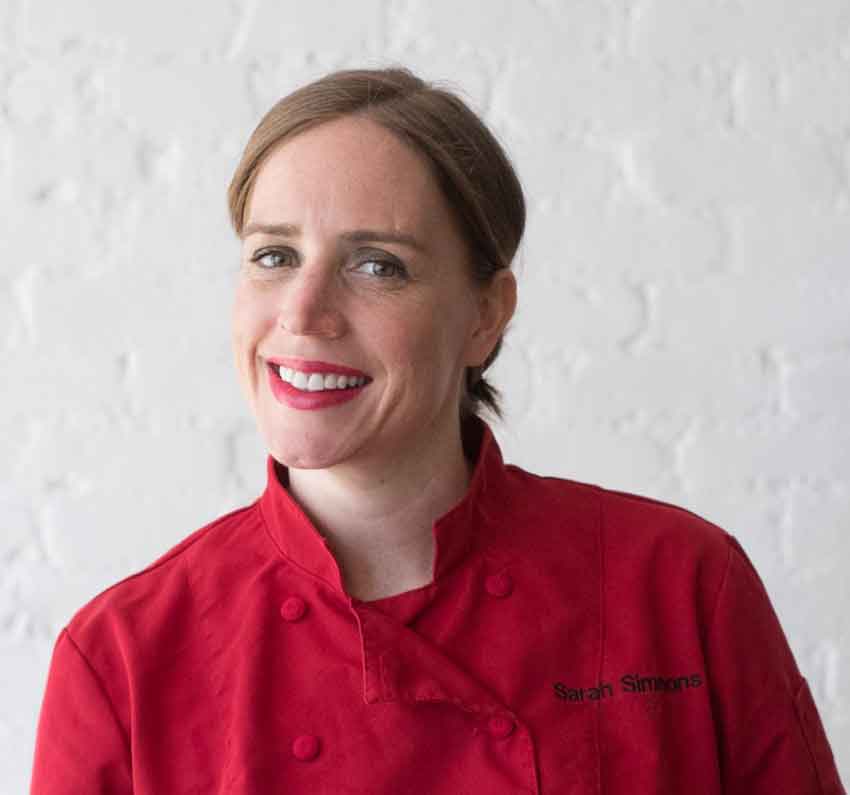
Photo courtesy of Naveen Selvadurai
Kelly Hensel: You founded City Grit in 2011. Where did the inspiration come from to start a supper club?
Sarah Simmons: Well, we try not to call it a supper club or a popup. In the beginning I had a very informal supper club in my house. We didn’t call it a supper club because we didn’t charge for tickets. At the time, I was traveling a lot as a management consultant and every other Sunday I would have a group of friends over for dinner because I didn’t get to cook while I was traveling and I wanted to see my friends.
When I decided to take a stab at being in the “food world” I didn’t have the confidence that I could actually own a restaurant because I had no experience. Also, I wasn’t sure that making the same food every day was my jam anyway. Then, I spent time traveling around and talking to chefs and in every kitchen I visited outside of New York City there was a chef or line cook that would say to me “I’ve always wanted to cook in New York City one day.”
It set the wheels turning in my brain and I thought I’m going to open a place where I cook most of the time and I get to cook like I’ve been cooking my whole life which was very theme driven, like dinners at my apartment. Also, I wanted to create a platform for chefs to come in and cook their food in New York, giving them that opportunity that—it seemed to me—so many people were looking for.
That’s really how the idea of City Grit came to be. I had these media interviews and it was so much easier to talk about other people than it was to talk about yourself, so I would talk about the other chefs’ food, the chefs that I wanted to invite in, and why I thought this was an important concept. This turned the story from a popup or supper club into a story about a culinary salon being a platform for up-and-coming chefs, which created a new mission for me.
I was stepping out of the spotlight—which I was so happy about—and going out to find these up-and-comers to give them the chance to come and cook at City Grit. You usually only get invited to cook in someone’s restaurant in New York or invited to the Beard House after you are well on your way.
I am so grateful for City Grit because I did get to cook my food, and I used it as a test kitchen for all of the [restaurant] concepts that I hope to open one day. But that’s not what made City Grit special—it was the communality of the dining room and the excitement of the guest chefs as they got to essentially perform in New York.
Hensel: I know City Grit is the brand for your line of Williams-Sonoma products. Where else do you hope to take this idea?
Simmons: It was the intention to evolve it into a brand. It could never be sustainable and scalable if it were just this culinary salon in New York. We have planned to create City Grit experiences in other cities. You know, flipping it on its head a little bit where we bring a chef from the northeast to a different city to cook with chefs we think are up-and-comers there. Everyone seems to be doing guest chef dinners in New York now and it has kind of taken away that uniqueness that we had. About a year ago we really looked at it and said, “How can we evolve this brand? How can we do something different that still supports our overall mission?”
Part of me thinks that City Grit was so much work in New York, and doing it in another city is going to be quadruple the work. How are we going to do it? But, we were at the James Beard awards this year and so many chefs that were nominated and won had cooked at City Grit years prior. My friend leaned over to me during the ceremony and said, “This is why City Grit is important.”
It was in that moment that I thought she’s right. So, we’re doing a lot of different things. The product line is just a way to get national exposure for the brand and so that when we do bring City Grit to other cities there is an awareness of it and what the brand stands for.
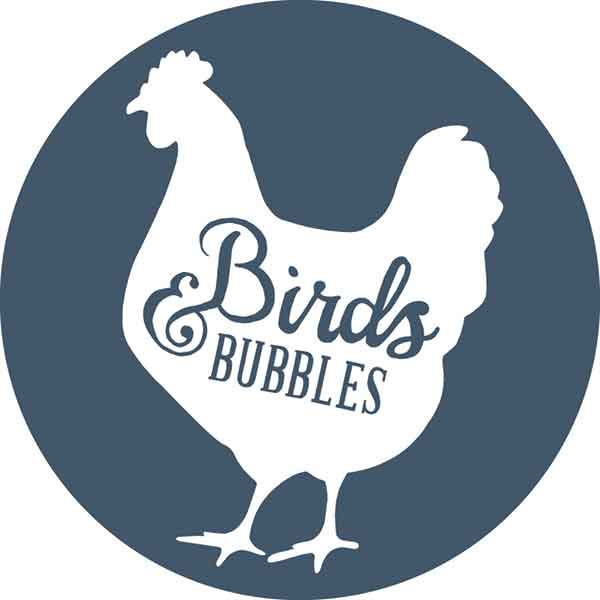
Hensel: After opening City Grit in 2011, what was the motivation behind opening Birds & Bubbles only three years later?
Simmons: We were actually looking for a new location for City Grit. My idea for Birds & Bubbles was to open it in a ski town because I love to ski. I had written the business plan and the menu for it but the whole time I thought it would in Park City [Utah] or Aspen [Colorado]. My operations manager found a spot she thought for be good for City Grit, but after we looked at it I told her it would be perfect for Birds & Bubbles. And she said, “What’s Birds & Bubbles?” Three days later, we had an investor packet ready. Six weeks later, we were halfway through raising the money and two months later we signed the lease. That was in February of 2014 and we opened in September 2014.
I have a number of concepts I want to open. I want our company to become really amazing operators. I have a business background first and foremost and a passion for cooking and putting those two together is why I’m still in business. There’s so many cooks that just want to make food. So, what we want to do as a company is to become expert operators so we can help other restaurants or chefs to become restauranteurs without having to do all of the day-to-day stuff that is required from an operational standpoint.
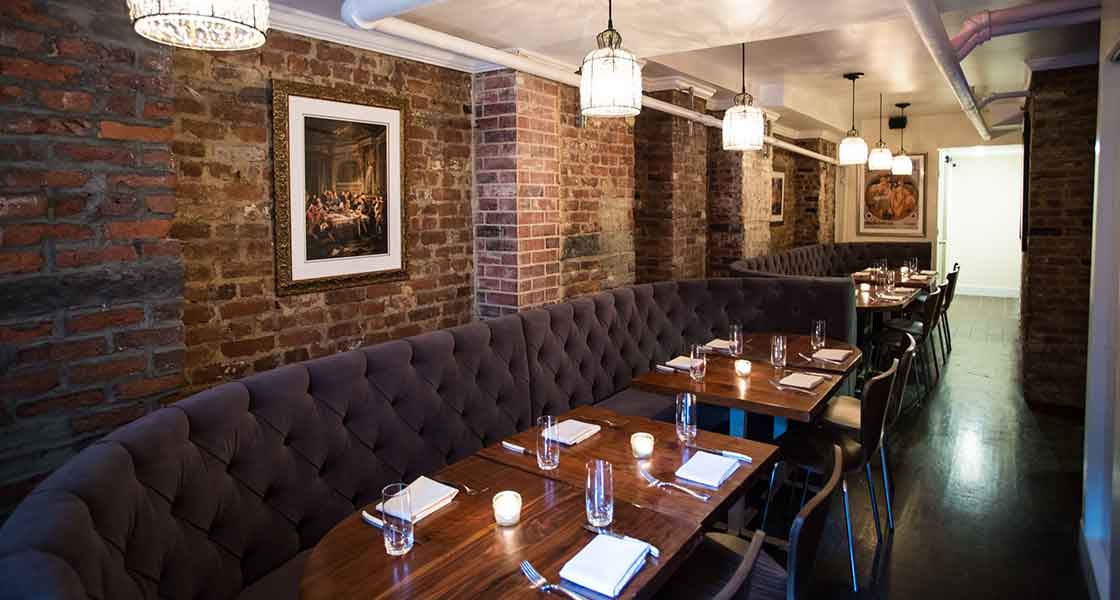
Hensel: So, Birds & Bubbles is named for fried chicken and champagne. The two seem to be very dichotomous. What brings them together?
Simmons: Champagne is looked at as something that you drink at a wedding, on your birthday, or when you are celebrating something huge. But I think it is one of the most perfect pairings for food, especially if you can get a champagne that is really dry with great acidity. It helps to balance out dishes—especially southern dishes that tend to be rich.
At City Grit we did a Sunday supper once a month where I served fried chicken. One Sunday a customer brought me a bottle of champagne and it was already chilled so we opened it. Everyone’s jaws dropped. They thought, “You are going to open this bottle of champagne on a Sunday night while everyone is eating fried chicken? You are not going to save it for a special occasion?”
That’s when the light bulb in my head turned on and I thought I’m going to open a place that celebrates the everyday. To me, Birds & Bubbles is more than just a fried chicken and champagne restaurant—it’s an everyday celebration. In my family we only had fried chicken on Sunday when my grandfather would make it. At City Grit we only had it once a month for Sunday supper. I wanted to have a place where you can have fried chicken every day. You could pop a bottle of bubbles on a Tuesday or a Thursday for no reason. It’s all about elevating southern food, pairing it with this wine we think is misunderstood and fantastic, and then making it fun.
Hensel: I had read that you guys do a toast every night…
Simmons: Yes, so every night at some point in the evening no matter where everyone is in the course of their dinner, we stop the dining room and everyone—the guests, the manager from the floor, the servers, and if I am out of the kitchen I’ll participate—toasts together. We call it Today’s Toast and everyone has a shot of champagne and we toast something. Like on July 6 we toasted National Fried Chicken Day. At City Grit there was this energy in the room because everyone was coming together for one night, for a dinner that was only happening once, and we have now found a way to bring some of that magic to the dining room at Birds & Bubbles because now everyone is getting the opportunity to celebrate in that moment that one night.
Hensel: What’s the secret to your fried chicken?
Simmons: Well, I think the most important thing is to start with happy chickens. They are raised in a happy environment and a lot of care is given to them. We buy all our chicken chickens from a conglomerate of farms in Pennsylvania.
Then, I am a big fan of using a cure or dry brine on chicken—especially because our chicken is all air chilled. So it never sees water and it’s never frozen. It would break my heart to dunk those amazing chickens into gallons and gallons of water or buttermilk or brine. We break the chicken down and coat it with a seasoning we have developed, and then let that sit for 24 to 48 hours. Anyone can make a great crispy, tasty, crust, but we get comments all the time that our chicken is so good. And it’s because of those two things—seasoning and that the chicken comes from a great place.
We only do a quick dip in buttermilk and egg and then it goes into the flour. I tell my cooks that when you put the chicken in the flour, cover it like you’re packing someone in snow but you want them to be able to get out. Pretend like it’s someone you love, so you don’t want to hurt them but you want to cover them completely. So that’s how they do it. There is a delicacy to their hands as they move—tossing the flour over the chicken and giving it a light pat, pat, pat, and picking it up easily out of the flour and into the pan. We pan fry—instead of deep frying—every piece of chicken. So, it ends up with a very light crust.
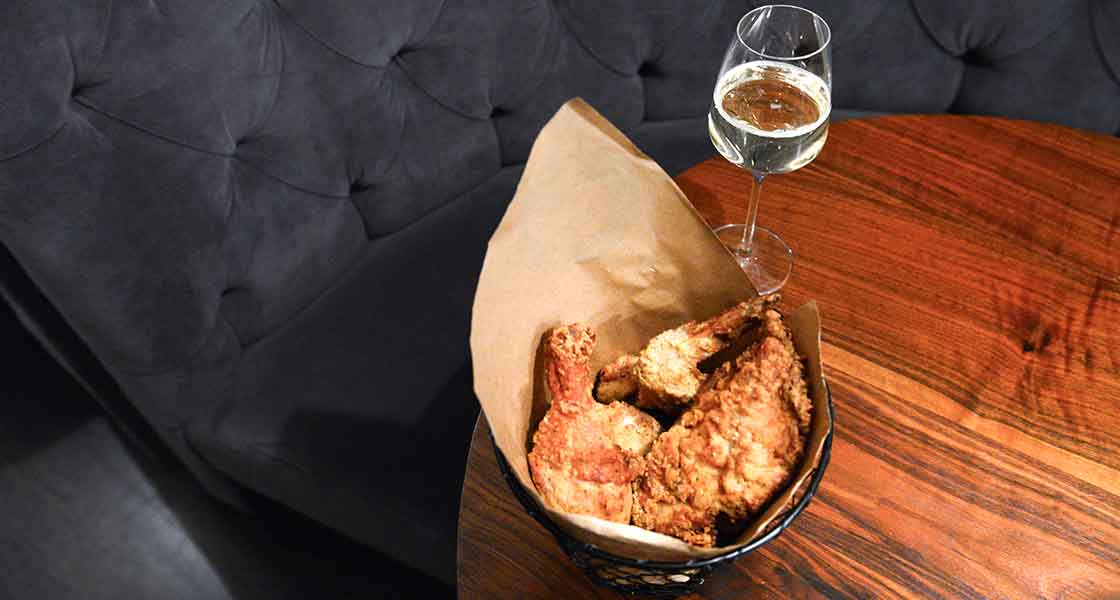
Hensel: I heard that you had the opportunity to serve the O, The Oprah Magazine staff, including Oprah Winfrey, your fried chicken. How do you keep something like fried chicken tasting good at an event like that?
Simmons: We were cooking it in an office building with no kitchen and serving food to 100 people and one of them was Oprah Winfrey. It was both the most stressful and amazing day of my life.
I think that it is a challenge. The other day we brought Eater lunch for National Fried Chicken Day, and we had this whole conversation with the manager about whether to take the chicken cold or hot. Hot is hard because you put it in a hot box, and you can’t cover it because the crust gets moist. I would rather serve crispy cold chicken than soggy hot chicken but even with just lukewarm chicken you never know with the travel times in New York. We ended up going with room temperature crispy chicken. I do think that’s one of my favorite things about the chicken at Birds & Bubbles—it’s great cold.
Hensel: And I assume Oprah loved your fried chicken?
Simmons: I think it went really well. She took some wings for the road so I would say we did a good job.
Hensel: We talked briefly about your line of retail products at Williams-Sonoma. Was it a challenge to ensure that the quality of the retail products was just as good as what you serve in your restaurant?
Simmons: Actually, Williams-Sonoma made it very easy. I think that there is something about working with a company that is all about excellence and all about making the home cook the star. You can’t do that if you are selling an inferior product and so they’re all about precision and excellence. From the get go aligning with them was a win-win because we believe in the same thing. We believe in giving home cooks the tools they need to shine in their own kitchen and we believe in putting out a superior product.
It was really one of the easiest experiences I’ve ever had in that I gave them my recipes and they worked with their food development team and sent me samples. I would taste the samples and send notes back and then they would send me more samples. We have some rubs coming out next year for grilling season and those only took one round of development work. I sent them the recipes, they sent me samples, and every single one of them was spot on. With the sauces that are out now, I was surprised how few tweaks and back-and-forth we had to have.
Hensel: You mentioned some rubs coming out in time for next grilling season. So, is this a growing line for you?
Simmons: I hope so, yes. It is really fun to see your stuff in the store. It’s still a little surreal for me.
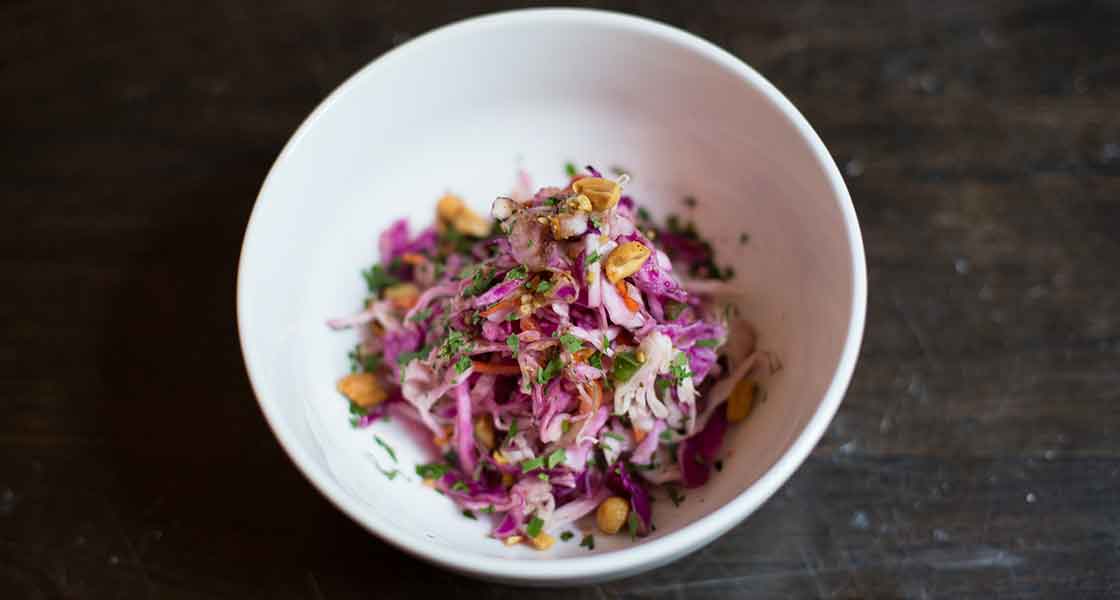
Photo courtesy of Donny Tsang
Carolina Coleslaw
Yield: 3 Quarts Dressing
Ingredients:
- 8.7 oz pickled mustard seeds
- 1 lb mayonnaise
- 1.5 lb sour cream
- 2.8 oz Dijon mustard
- 16 oz white balsamic vinegar
- 16 oz buttermilk
- 8 oz agave
- 2 tbsp sumac
- 4 quarts halved and thinly sliced sweet onion
- 2 oz salt
- 2 oz sugar
- 4 lb green and purple cabbage, julienned by hand (about 10 quarts, packed)
- 2 lb carrots, Peeled and julienned by hand (about 2.5 quarts)
Method
- Whisk mayonnaise and buttermilk and season with agave and sumac. Combine onions, salt, and sugar and let stand at least one hour.
- Mix 1 quart carrot and 4 quart cabbage with 1 quart onion mixture. Cover and refrigerate until ready to mix with dressing.


